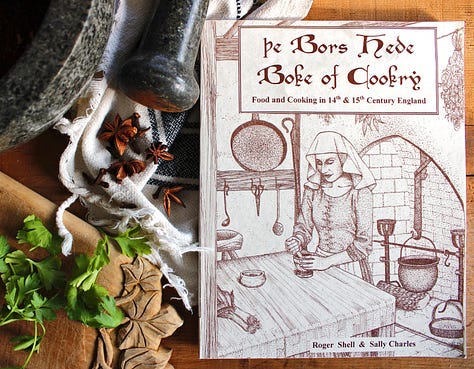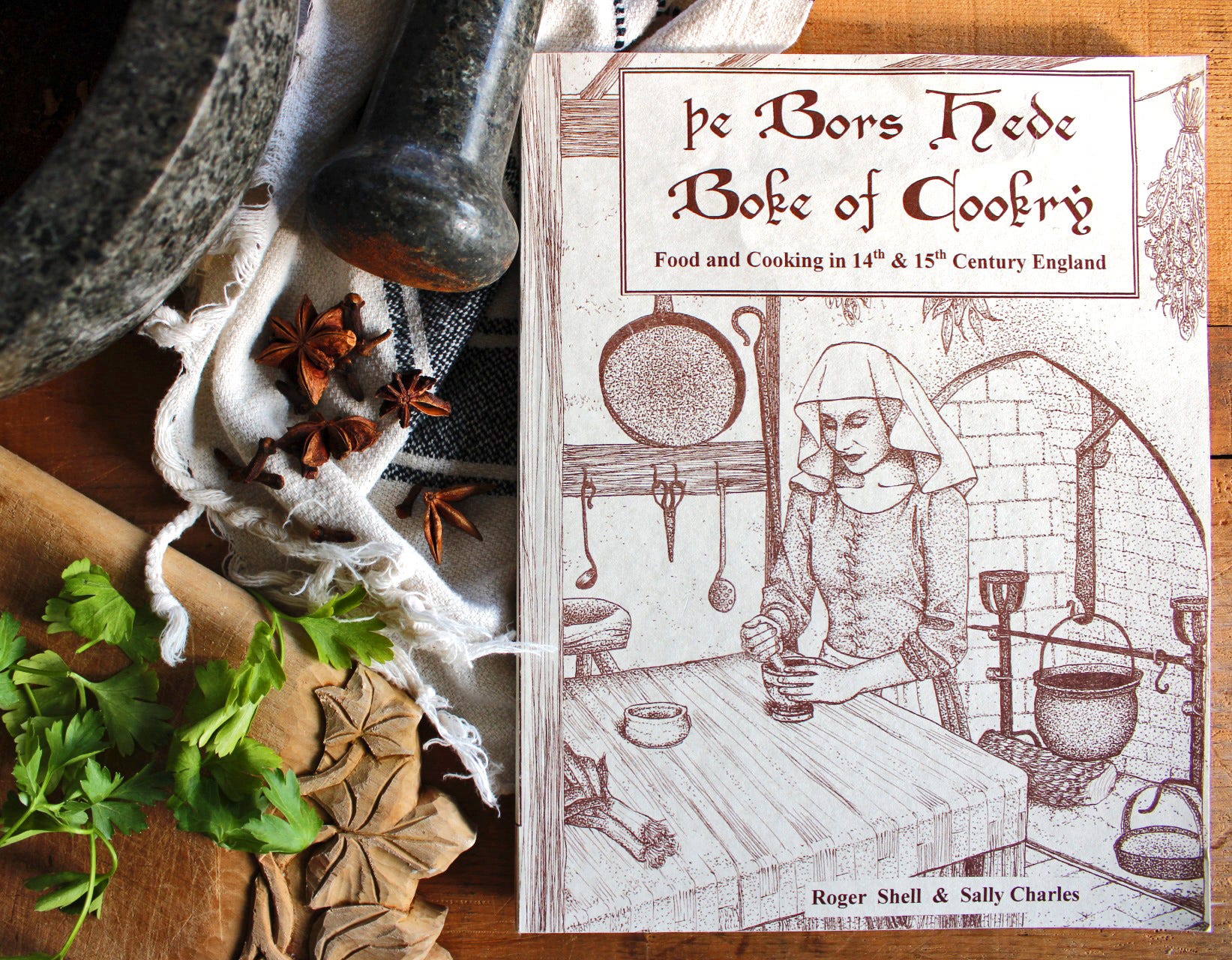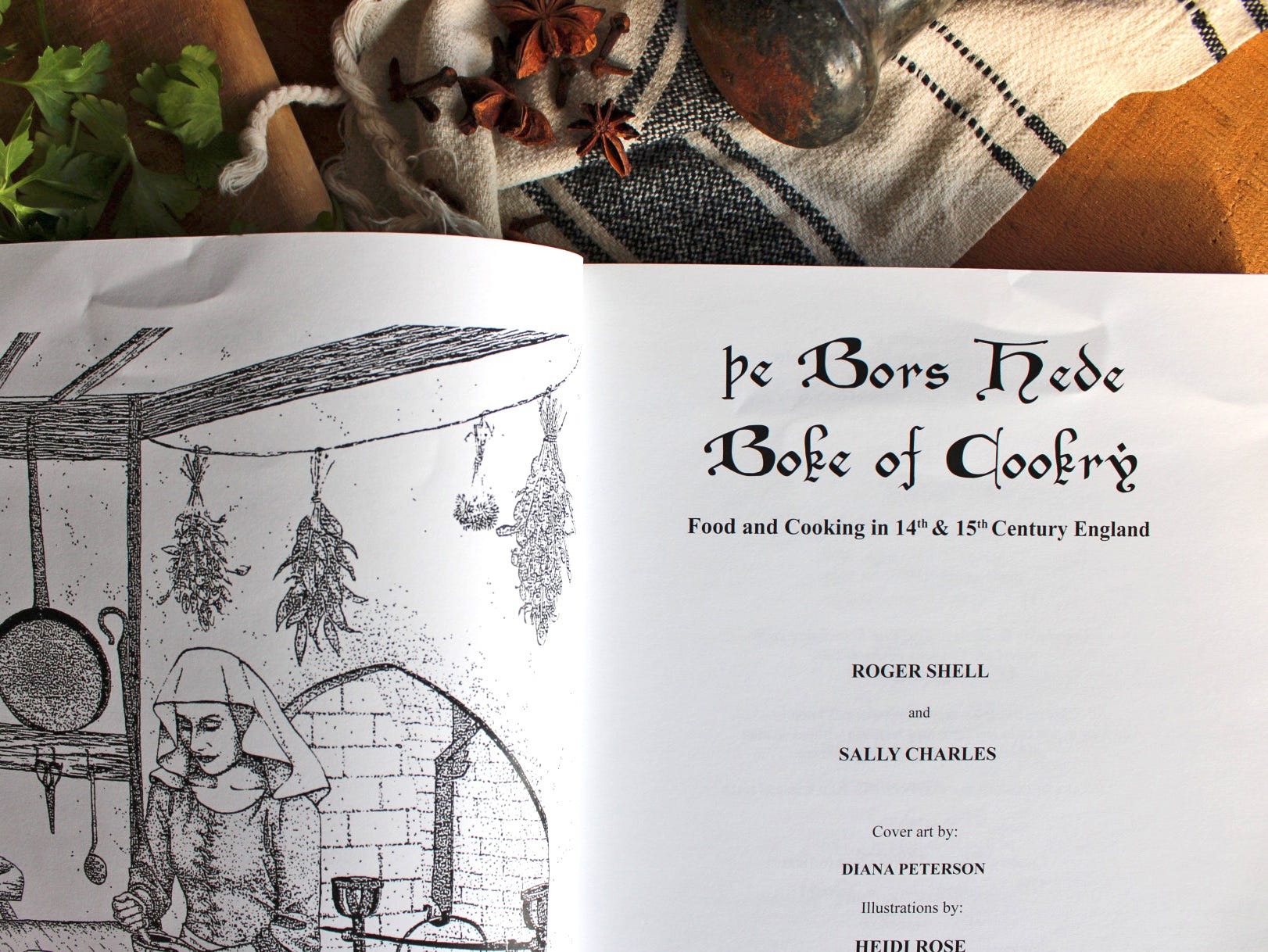Giveaway: Medieval cookery book
From our local living history museum
EDIT:
Giveaway is now closed! Thank you so much to everyone who entered. More giveaways will be on the horizon!
Welcome, friends. I’m Kristin: a Pacific Northwest artist, mom, & farmer offering support for seasonal, local, liturgical living. Together, we’ll explore the agrarian heritage of the Church calendar and ideas of sacred time & sacred place.
Subscribe for free to receive reflections about once a month. If you’d like to go deeper, delve into all my posts here, gather for live online events, and access my entire library of printables, please consider joining our community!
Hidden in the woods, not far from us here in the Pacific Northwest, is Camlann Medieval Village - a living history museum portraying a rural English village in the year 1376, hosting seasonal festivals & feasts & a year-round restaurant dubbed the “Bors Hede.” They host classes, too - from Medieval shoemaking to open-hearth cookery classes.
Camlann is an immersive experience: as you wander through the village on a festival day, you can smell the smoke from the forge wafting upward, hear the hurdy-gurdy in the distance, and wander past the stalls of ‘villagers’ hard at work.
And these portrayals vary with the season as they wind their way through the Medieval liturgical year: at May Faire, you can twist ribbons around the May-pole…during the Midsomer festival, you’re invited to help with the bonfire before heading to the St. John feast. Michelmasse-tide is when their enormous stone cider mill comes to life.
Camlann Medieval Village is dedicated to offering the public powerful personal experiences of history, including multiple learning and performing arts opportunities, built upon thorough research of rural communities in fourteenth-century England to provide a deeper understanding of the relationship between historical events and western society today.
Crowning all of the village festivals - and extending a bit beyond their festival season, too - are Camlann’s feasts, when guests get to wander down to the banquet hall of the Bors Hede restaurant and sit by an open hearth as course after course of Medieval food is brought out.
The feasts, of course, are coordinated with the liturgical festivals at the village. Here’s how Camlann describes their upcoming Lenten feast:
“The fourth Sunday in Lent, known as Mid-Lent Sunday, was sometimes treated as a feast to brighten lagging spirits. Skillful cooks found ways to follow the fasting rule without denying pleasure to the palate: yeast dough, for example, was substituted for pastry with egg binders, and almond milk for meat stock in stews; food was fried in oil instead of in fat; and fish was substituted for flesh and fowl. Thusly were fine meat dishes transformed into delicious Lenten equivalents. In this spirit, we have created for your enjoyment a ten-dish meal with seafood, vegetables, and sweets, with minstrels entertaining with live music and stories.”
So, not only do guests get to experience the ongoing work of Medieval villagers at Camlann: they can also be immersed in the seasonal, liturgical flavors of each village feast.
Camlann initially began as a way of sharing Medieval cookery with our region, experimenting with Medieval recipes & hosting banquets; eventually, roots were put down to form an actual living history village.
One of the gems offered for sale at Camlann is their Medieval cookery book: Ye Bors Hede Boke of Cookry: Food and Cooking in 14th & 15th Century England. The making of this book helped to form the village into what it is today, as it was a long process of trial & error in trying to recreate Medieval recipes. Many of the meals that Camlann serves in the Bors Hede or at their feasts come straight from this cookbook; it’s sold at the village, but it’s a treasure that you can only rarely find for sale online.
So, even if you can’t make it to this living history museum, I’m going to bring a piece of it to you.
…I’m offering Camlann’s cookery book as a giveaway to one of my lovely subscribers!
More about Ye Bors Hede Boke of Cookry: Food and Cooking in 14th & 15th Century England
Written by Roger Shell & Sally Charles; cover art by Diana Peterson; beautiful woodcut-style illustrations by Heidi Rose
Published by the Camlann Medieval Association, first in 1998, and again in 2006
214 pages
Includes a helpful introduction to Medieval foods, gardens, kitchens, & tools
Details the Middle English primary sources used when creating this book
Features a plethora of recipes, each featuring the Middle English text & source; a modern English translation; and amounts of ingredients as well as method of preparation, based on the authors’ cooking experiments
Has a helpful glossary of Middle English terms



DETAILS
To enter, please read this bit of nitty-gritty…
Giveaway is open to all Hearthstone Fables Substack subscribers
Paid subscribers’ entries count as 5 entries
Open to worldwide shipping
This giveaway is not sponsored by Substack or by Camlann Medieval Village; I bought an extra copy of the book to share with my wonderful readers
…and then leave a comment below!
Giveaway closes on Friday, February 14 (St. Valentine’s Day!) at 10 am PST, and a winner will be chosen at random!
Winter weather is lasting long here, and Medieval pottage with some warm spices sounds like the perfect fit to me.
Good luck, friends. This is such a sweet book! (And keep an eye out for more posts about Camlann, now that I’ve finally introduced it to you…)
Pax et bonum,
Kristin
If you’d like to make a one-time donation, I have a PayPal Tip Jar - please know that I’m so grateful for your monetary support, which really does help me continue to do this work that I’m so passionate about!
For those who are able to support a monthly or annual paid subscription, I offer new printables, extra posts, live online gatherings, and access to my whole library of printables: the Scriptorium. I’m so grateful for your generosity, which helps to support my work through the purchase of additional books for research, art supplies, funds for guest speakers, and more!
For more reflections and perspectives on the liturgical year, please visit Signs + Seasons: a liturgical living guild!









I spent many years driving by here on the way to church as a child… what went on behind that tale wood fence hidden beneath the gigantic Fir trees??? And then the magic when we finally visited - ! It literally felt like entering a different world. It’s such a special feeling to revisit the enchantment through your writing. 💛
Living near a medieval living history museum is the sort of thing young me dreamed of. Thankfully I have a colonial home to help fulfill some of that fascination with the past. Definitely have found food and feasting to be our gateway to the liturgical/seasonal living side of faith, so it’s really fascinating to learn about how food was also what was the starting point for this museum!